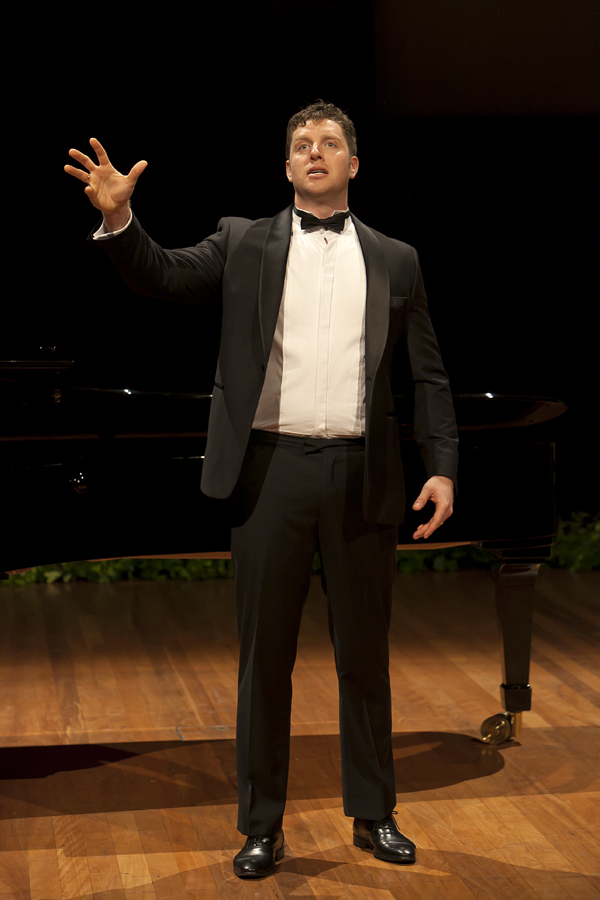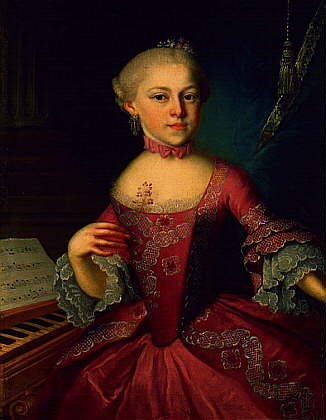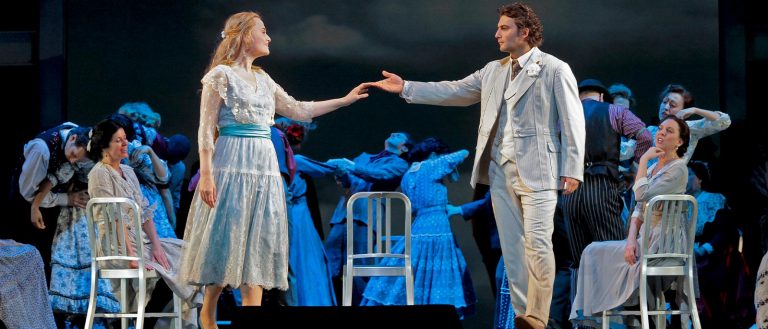The City’s Quiet Achiever Heads South

Elaine Chia considers herself a lucky woman. She has the singular good fortune of successfully converting her lifelong passion for music, into her career, prompting her late grandfather to comment “I can’t believe they pay you to do this!”
The vivacious erstwhile CEO of Sydney’s City Recital Hall, recently left this post to move to Adelaide where she will take up the role of Executive Director at the Adelaide Festival of the Arts. In 2016, Elaine Chia was appointed inaugural CEO of the City Recital Hall which opened in October 1999. When she came to her post, the CRH hosted a total of 163 events in the financial year 2015-16. She leaves the venue with a legacy of having hosted 286 performances in 2018-19, of which 115 were presented by the CRH itself.
Quietly chatting in the uncharacteristically deserted and darkened foyer of the CRH on a weekday morning, Chia recounts some of the highlights of her time at ‘Angel Place.’ “There so many highlights,” she muses. “The first concert that I felt I’d programmed when I felt like I had connected with the artist and brought them to the stage was Kate Ceberano, in 2016, towards the end of my first year. That was really, really exciting” she says, her eyes dancing. It was a revelation for Ceberano as well, who had never been to the CRH, and was even unaware of its existence. Since then, she has returned to perform there every year.
Other highlights include presenting a concert by Chloe Charody and Sonja Shebeck. “They are a couple of friends who were students at the Conservatorium of Music when I worked there. Chloe is a composer who is now living in Berlin and getting amazing opera and ballet commissions; I took Sonja on a tour around Europe at the end of which she was asked to play with Nigel Kennedy. She’s been touring with him ever since. To be able to put them in concert with Ross Edwards and to have his support – this is why we exist. This is the opportunity that I have had here, to be able to not just provide opportunities for those artists but to introduce those artists to an audience who really love them – that’s been amazing.”
Chia’s first full-time job was with the Australian Youth Orchestra. Trained in the ‘classical’ Western European canon, she recognises that music has to evolve. However, her personal view is to leave the great masters well alone. “You just don’t want to tweak with the best. They are absolutely perfect in their own way and there is nothing better than listening to their music in its purest form. Having said that, I think that the new generation is looking to re-interpret some of the classics and put their own mark on them and there needs to be a space for that crossover. It’s difficult,” she acknowledges. “There is a balance and sometimes they will not get it right, but I like to think that if you open yourself up to listening to whole range of music, you might be listening to the next classical symphony – you just don’t know it at the time.”
Despite the increasing digitisation of entertainment, the ubiquity of the digital concert hall and the live-streaming of concerts, Chia firmly believes that there is a future for the bricks and mortar performance space. “It’s a place for people to come out and enjoy music as a community, as a shared experience. I do enjoy it, but I struggle with the digital experience as well, because for me, it requires a different type of concentration. It is a different type of entertainment. It is completely under your control, so you firstly have to agree to allow yourself to invest the time – you have to resist pressing the pause button or logging out if you’re busy. There is something that I love about the fact that you’re sitting in your seat surrounded by other people who are sharing your experience. You’re part of a captive audience and you have to let yourself go to whatever that experience is. I also truly believe that even though we’re moving to these digital encounters, people are craving that live experience because we don’t have those human connections in the same way anymore. Social media is so heavily curated you can literally have on your feed, everybody who thinks the same way as you do – has the same political leanings, the same religious leanings and they’re not going to challenge you. Whereas I can see, from the live events that we present, people are craving personal interactions that the digital experience can’t replace. It can augment, but it’s no substitute.”
Chia studied architecture at university and prior to her post at the CRH, worked at the Australia Exhibition at the Venice Biennale. Not surprisingly, visual elements are an integral component of her planning and she confesses to a “very strong personal passion for contemporary visual arts.” For Chia, the interior of the CRH is a blank canvas. “I looked at the walls and thought there was probably something we could create around here, and it’s nothing more than bringing together, artists and audience – an audience who may not necessarily go and see art by a young contemporary artist or at a gallery, unless it’s one of the more established galleries, so it doesn’t hurt to put that art in front of this audience. They may like it; they may not, but it livens our hall and brings in more people.” The CRH held its first exhibition opening a few weeks ago to a gathering of over 100 who witnessed a new interactive video project up on the top 2 levels, a partnership with Google Creative Labs and SBS Creative Labs. “That’s really exciting” says Chia. “it brings technology to the venue and opens our minds.”
Like many children of South Asian and South East Asian parents, Chia describes her upbringing as “conservative.” She learnt the piano, played the organ and was school music captain. Her 16th birthday present from her grandparents was a grand piano. Yet, she was told she could not pursue music as a career. Chia had studied art at school and so architecture seemed the obvious choice for a ‘real’ vocation. The attraction of performance didn’t abate and while Chia was completing her 4-year bachelor’s degree in internal architecture at RMIT, she continued to work in music theatre. “Once I’d got my degree, my grandparents were happy for me to move on” she laughs. “Finally, I got a job at the conservatorium of music and I gave my grandfather my business card which had the university crest on it and he said ‘Now you have a real job!’ But I know that he was proud of me.”
Established in 1960, the Adelaide Festival of the Arts is held annually, in late summer. Highlights of the two-week inaugural event included performances by the Sydney Symphony, Dave Brubeck and his jazz ensemble, the Hogarth Puppets from London and an exhibition of the works of English landscape painter J.M.W. Turner.
Initially a biennial event, the popularity of the event has seen it held annually since 2012. It is one of the largest multi-arts festivals in the world, held around the Adelaide Festival Centre precinct. The Adelaide Festival Theatre, home to many of the events, was Australia’s first multi-purpose arts hub, opened in June 1973, by Prime Minister Gough Whitlam, at a gala performance of excerpts from Beethoven’s Fidelio and his 9th (Choral) Symphony. Notable directors of the past have shaped the festival into the major event that it is today, among them, Sir Robert Helpmann, Jim Sharman, the Earl of Harewood, Barrie Kosky, Peter Sellars, and Adelaide-born performer Robyn Archer, who in 1998 became the first female director.
Neil Armfield and Rachel Healey have been co-directors since 2017 and Chia is looking forward to the opportunity to work with them, having worked with Armfield at Sydney’s Belvoir Street Theatre 20 years ago. Her plans for the festival are influenced by the concept of ‘place’ which has fascinated her in recent years. “I have become interested increasingly around ‘place’ and what festivals and art and culture do for the identity of a place. I’d like to think that in my 4 years here, the City Recital Hall has come to mean more to more people and I guess that’s the interest that I have for Adelaide as well – it is already the best arts festival in Australia. It has an amazing program but I want to know about the working of the festival, what reaction the people of Adelaide have to it, and that’s not just about artistic output. It’s the journeys to and from venues and the buzz around them in which I’m very interested and where I can contribute. I want to learn about this city that I’ve never lived in, see how it ticks and see what I can bring to it.”
Pursuing passion as work hasn’t dulled Chia’s ardour. “I have had an amazing ride for 4 years. I was the lucky one who was gifted with this venue and whoever come in next is going to have so much fun.”
Shamistha de Soysa for SoundsLikeSydney©






